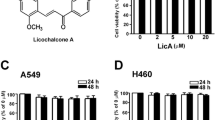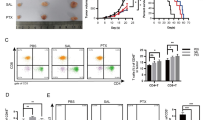Abstract
Lung cancer is one of the most common malignancies worldwide. Actinidia chinensis Planch root extract (acRoots) was found to have the capacity of the anti-tumor, although the molecular mechanisms remain unclear. The present study aims to investigate the molecular mechanisms by which lung cancer cells sense to inhibitory effects of acRoots with a special focus on immune-associated gene profiles. We firstly provide a preclinical evidence that acRoots can significantly inhibit lung cancer cell proliferation and apoptosis via the PI3K-OASL signal pathway. The heterogeneous alterations of immune-associated gene profiles of lung cancer cell types were measured after treatment with various doses of acRoots. The OASL gene was identified as the key regulator in molecular networks of acRoots-treated lung cancer cells and validated. The OASL gene plays an important role in the regulation of lung cancer cell sensitivity to acRoots, which modulated by the PI3K signal pathway. Thus, our data indicate that OASL can be one of the decisive regulators to maintain lung cancer cell susceptibility to acRoots and may be associated with the development of drug resistance. The regulation of OASL can be an alternative strategy to improve drug efficacy during cancer therapies.







Similar content being viewed by others
References
Cheng QL, Li HL, Huang ZQ, Chen YJ, Liu TS. 2beta, 3beta, 23-trihydroxy-urs-12-ene-28-olic acid (TUA) isolated from Actinidia chinensis Radix inhibits NCI-H460 cell proliferation by decreasing NF-kappaB expression. Chem Biol Interact. 2015;240:1–11.
Dunn GP, Old LJ, Schreiber RD. The immunobiology of cancer immunosurveillance and immunoediting. Immunity. 2004;21:137–48.
Eckert F, Jelas I, Oehme M, Huber SM, Sonntag K, Welker C, et al. Tumor-targeted IL-12 combined with local irradiation leads to systemic tumor control via abscopal effects in vivo. Oncoimmunology. 2017;6:e1323161.
Fang T, Hou J, He M, Wang L, Zheng M, Wang X, et al. Actinidia chinensis Planch root extract (acRoots) inhibits hepatocellular carcinoma progression by inhibiting EP3 expression. Cell Biol Toxicol. 2016;32:499–511.
Garg AD, Agostinis P. Cell death and immunity in cancer: from danger signals to mimicry of pathogen defense responses. Immunol Rev. 2017;280:126–48.
Gu S, Li G, Zhang X, Yan J, Gao J, An X, et al. Aberrant expression of long noncoding RNAs in chronic thromboembolic pulmonary hypertension. Mol Med Rep. 2015;11:2631–43.
Guo WF, Lin RX, Huang J, Zhou Z, Yang J, Guo GZ, et al. Identification of differentially expressed genes contributing to radioresistance in lung cancer cells using microarray analysis. Radiat Res. 2005;164:27–35.
Gustafsson M, Nestor CE, Zhang H, Barabasi AL, Baranzini S, Brunak S, et al. Modules, networks and systems medicine for understanding disease and aiding diagnosis. Genome Med. 2014;6:82.
He S, Mao X, Sun H, Shirakawa T, Zhang H, Wang X. Potential therapeutic targets in the process of nucleic acid recognition: opportunities and challenges. Trends Pharmacol Sci. 2015;36:51–64.
He M, Hou J, Wang L, Zheng M, Fang T, Wang X, et al. Actinidia chinensis Planch root extract inhibits cholesterol metabolism in hepatocellular carcinoma through upregulation of PCSK9. Oncotarget. 2017;8:42136–48.
Helmis C, Blechner C, Lin H, Schweizer M, Mayr GW, Nielsen P and Windhorst S. Malignant H1299 tumour cells preferentially internalize iron-bound inositol hexakisphosphate. Biosci Rep. 2013. https://doi.org/10.1042/BSR20130079.
Ibsen MS, Gad HH, Andersen LL, Hornung V, Julkunen I, Sarkar SN, et al. Structural and functional analysis reveals that human OASL binds dsRNA to enhance RIG-I signaling. Nucleic Acids Res. 2015;43:5236–48.
Lu X. Impact of IL-12 in cancer. Curr Cancer Drug Targets. 2017;17:682–97.
Lu J, Wang W, Xu M, Li Y, Chen C, Wang X. A global view of regulatory networks in lung cancer: an approach to understand homogeneity and heterogeneity. Semin Cancer Biol. 2017;42:31–8.
Malilas W, Koh SS, Srisuttee R, Boonying W, Cho IR, Jeong CS, et al. Cancer upregulated gene 2, a novel oncogene, confers resistance to oncolytic vesicular stomatitis virus through STAT1-OASL2 signaling. Cancer Gene Ther. 2013;20:125–32.
Shi L, Dong N, Fang X, Wang X. Regulatory mechanisms of TGF-beta1-induced fibrogenesis of human alveolar epithelial cells. J Cell Mol Med. 2016;20:2183–93.
Song WY, Xu GH, Zhang GJ. Effect of Actinidia chinensis planch polysaccharide on the growth and apoptosis, and p-p38 expression in human gastric cancer SGC-7901 cells. Zhongguo Zhong Xi Yi Jie He Za Zhi. 2014;34:329–33.
Wang X, Peer D, Petersen B. Molecular and cellular therapies: new challenges and opportunities. Mol Cell Ther. 2013;1:1.
Wang W, Lv J, Wang L, Wang X, Ye L. The impact of heterogeneity in phosphoinositide 3-kinase pathway in human cancer and possible therapeutic treatments. Semin Cell Dev Biol. 2017;64:116–24.
Zhu WJ, Yu DH, Zhao M, Lin MG, Lu Q, Wang QW, et al. Antiangiogenic triterpenes isolated from Chinese herbal medicine Actinidia chinensis Planch. Anti Cancer Agents Med Chem. 2013;13:195–8.
Zhu J, Zhang Y, Ghosh A, Cuevas RA, Forero A, Dhar J, et al. Antiviral activity of human OASL protein is mediated by enhancing signaling of the RIG-I RNA sensor. Immunity. 2014;40:936–48.
Zhu J, Ghosh A, Sarkar SN. OASL—a new player in controlling antiviral innate immunity. Curr Opin Virol. 2015;12:15–9.
Funding
The work was supported by the Zhongshan Distinguished Professor Grant (XDW), the National Nature Science Foundation of China (91230204, 81270099, 81320108001, 81270131, 81300010), the Shanghai Committee of Science and Technology (12JC1402200, 12431900207, 11410708600, 14431905100), the Operation funding of Shanghai Institute of Clinical Bioinformatics, the Ministry of Education for Academic Special Science and Research Foundation for PhD Education (20130071110043), and the National Key Research and Development Program (2016YFC0902400, 2017YFSF090207).
Author information
Authors and Affiliations
Corresponding author
Electronic supplementary material
Supplement Figure 1
Chemical structure of 2β, 3β, 23-trihydroxy-urs-12-ene-28-olic acid (A) and 2α, 3α, 19α, 23, 24-pentahydroxyurs-12-en-28-oic acid (B). (GIF 9.02 kb)
Supplement Figure 2
Select a valid small interference sequence. And verify OASL siRNA-1176 on lung cancer cell proliferation. (A) The mRNA level of OASL was evaluated after treated with different OASL siRNA which were provided by biological company. (B) H460 cells proliferation was measured after treated with OASL siRNA-1176. (GIF 36.9 kb)
Supplement Figure 3
Response of OASL downstream inflammatory genes after inducing by acRoot. The mRNA level of IL-8 (A) and IL-12 (B) was measured after treated with 1, 5, 10 mg/ml acRoots and OASL siRNA-1176. (GIF 40.9 kb)
ESM 1
(XLS 43.6 mb)
Rights and permissions
About this article
Cite this article
Lv, J., Wang, L., Shen, H. et al. Regulatory roles of OASL in lung cancer cell sensitivity to Actinidia chinensis Planch root extract (acRoots). Cell Biol Toxicol 34, 207–218 (2018). https://doi.org/10.1007/s10565-018-9422-4
Received:
Accepted:
Published:
Issue Date:
DOI: https://doi.org/10.1007/s10565-018-9422-4




